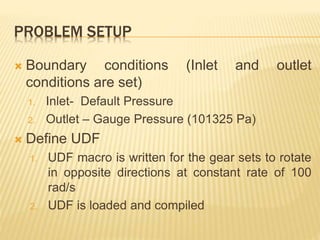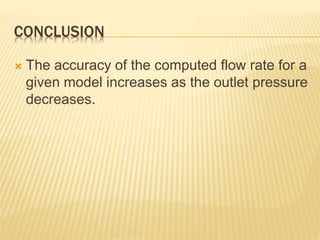CFD Introduction using Ansys Fluent
- 1. ANALYSIS OF GEAR PUMP USING ANSYS FLUENT SAVANI BHAVIK B.
- 2. INTRODUCTION What is CFD? CFD: A methodology for obtaining a discrete solution of real world fluid flow problems. Discrete solution: Solution is obtained at a finite collection of space points and at discrete time levels
- 3. CFD IN A NUTSHELL Solving the governing equation of fluid by using computational methods under various physical conditions (e.g. heat transfer, radiation, electromagnetic field, nuclear reaction…etc.) to study different phenomena encountered in the numerous branches of physical science.
- 4. CFD APPLICATION Aerospace Automotive Chemical Processing Polymerization reactor vessel- prediction of flow separation and residence time effects. Marine
- 6. BUILDING BLOCKS Geometry & grid generation module Problem setting module Solution Module Visualization Module What to: Presume • Boundary / initial conditions • Physical models & what to: Neglect • Physical phenomena (i.e. heat transfer, chemical reaction…etc) • Properties (i.e. Compressibility, real gas…etc) & what to : Calculate • Unknowns • Relationships between field variable Solution methods & algorithms • Spatial / temporal discretization schemes • Convergence criterion • Interpolation methods
- 7. METHODOLOGY During Preprocessing The geometry of the problem is defined The volume occupied by the fluid is divided into discrete cells. The mesh may be uniform or non-uniform The physical modelling is defined – for eg. The equation of motion + enthalpy + radiation + species conservation Boundary conditions are defined. This involves specifying the fluid behavior and properties at the boundaries of the problem. For transient problems, the initial conditions are also defined The simulation is started and the equation are solved iteratively as a steady-state or transient Finally a postprocessor is used for the analysis and visualization of the resulting solution.
- 8. FINITE VOLUME METHOD USED IN DISCRETIZATION The finite volume method (FVM) is a common approach used in CFD codes, as it has an advantage in memory usage and solution speed, especially for large problems, high Reynolds number turbulent flows, and source term dominated flows (like combustion). In this method the governing partial differential equations are recast in the conservative form and then solved over a discrete control volumes and thus guarantees the conservation of fluxes through a particular control volume. Here Q is the vector of conserved variables, F is the vector of fluxes V is the volume of the control volume element, and A is the surface area of the control volume element. The finite volume equation yields governing equations in the form:
- 9. FINITE ELEMENT METHOD The finite element method (FEM) is used in structural analysis of solids, but is also applicable to fluids. It is much more stable than the finite volume approach. However, it can require more memory and has slower solution than the FVM.
- 10. FINITE DIFFERENCE METHOD The finite difference method (FDM) has historical importance and is simple to program. It is currently only used in few specialized codes, which handle complex geometry with high accuracy and efficiency by using embedded boundaries or overlapping grids (with the solution interpolated across each grid).
- 11. PURPOSE OF PRESENTATION GEAR PUMP A gear pump uses the meshing of gears to pump fluid by displacement. There are two main variation: external gear pump and internal gear pump Gear pump are positive displacement meaning they pump a constant amount of fluid for each revolution.
- 12. THEORY OF OPERATION As the gears rotate they separate on the intake side of the pump, creating a void and suction which is filled by fluid. The fluid is carried by the gears to the discharge side of the pump, where the meshing of the gears displaces the fluid. Mechanical clearances are small, which prevents the fluid from leaking backwards. Rigid design of the gears and houses allow for very high pressures and the ability to pump highly viscous fluids.
- 14. PROCESS IN SOLVING PROBLEM Set up a problem using the 2.5D dynamic re- meshing model. Specify dynamic mesh modeling parameters. Specify a rigid body motion zone. Specify a deforming zone. Use prescribed motion UDF macro. Perform the calculation with residual plotting. Post process using CFD-Post.
- 15. PROBLEM STATEMENT The current setup is an external gear pump which uses two external spur gears. Gears rotate at constant rate of 100 rad/s. Fluid- oil (Density- 844 kg/m3 & Viscosity – 0.02549 kg/m-s) Mass flow rate of fluid in and out of the pump is of interest.
- 17. MESH
- 18. PROBLEM SETUP General setting- Solver 1. Type- pressure-Based 2. Velocity Formulation- Absolute 3. Time – Transient Models- Viscous - Realizable k-epsilon with standard wall function
- 19. PROBLEM SETUP Material 1. Material – oil 2. Density -844 kg/m3 3. Viscosity – 0.02549 kg /m-s Cell Zone conditions 1. Each cell zone, select material as oil
- 20. PROBLEM SETUP Boundary conditions (Inlet and outlet conditions are set) 1. Inlet- Default Pressure 2. Outlet – Gauge Pressure (101325 Pa) Define UDF 1. UDF macro is written for the gear sets to rotate in opposite directions at constant rate of 100 rad/s 2. UDF is loaded and compiled
- 21. PROBLEM SETUP Mesh Motion Setup 1. Dynamic mesh Mesh Method: Smoothing Remeshing Remeshing Method 2.5D Parameters Min. Length Scale – Default Max. Length Scale – Default Size Remeshing Interval - 1 2. Motion of gear 1 Zone – Gear 1 Type – Rigid body Motion UDF/ profile – gear1::libudf C.G (X,Y,Z)- (0, 0.085, 0.005) 3. Motion of gear 2 Zone – Gear 2 Type – Rigid body Motion UDF/ profile – gear2::libudf C.G (X,Y,Z) – (0, -0.085, 0.005)
- 22. PROBLEM SETUP 4. Motion of symmetry-1 gear_fluid Zone – sym1-gear_fluid Type – Deforming Geometry Definition – Plane Point on Plane (X ,Y, Z) – (0, 0, 0.01) Plane normal (X ,Y, Z) – (0, 0, 1) Meshing Options: Methods: Smoothing & Remeshing Zone Parameters Min. Length Scale – 0.0005 Max. Length Scale- 0.002 Max. Skewness – 0.8 5. Motion of symmetry-2 gear_fluid Zone – sym1-gear_fluid Type – Deforming Geometry Definition – Plane Point on Plane (X ,Y, Z) – (0, 0, 0) Plane normal (X ,Y, Z) – (0, 0, 1) Meshing Options: Methods: Smoothing Zone Parameters Min. Length Scale – 0.0005 Max. Length Scale- 0.002 Max. Skewness – 0.8
- 23. PROBLEM SETUP Dynamic mesh Time step size – 5e-6 No. of steps – 1000 Integrate Preview control Time step size – 5e-6 No. of steps – 1000
- 24. SOLUTION Solution methods Retain defaults Solution controls Relaxation factor of pressure- 0.4 Momentum – 0.5 Turbulent K.E – 0.7 Turbulent dissipation rate – 0.7 Turbulent viscosity – 0.75 Solution initialization TKE – 0.1 Gauge pressure – 101325 Pa Initialize the solution Run Solution (Run calculation for 150 time steps) Time step size- 5e-6 No. of time steps – 3000 Max iterations / time step – 40 Calculate
- 27. Pressure Contour
- 29. CONCLUSION The accuracy of the computed flow rate for a given model increases as the outlet pressure decreases.
Editor's Notes
- #9: Eq- Navier stroke’s , mass and energy conservation equations. For this We begin with the incompressible form of the momentum equation and then the equation is integrated over the control volume of a computational cell.
- #18: The mesh is automatically read into fluent and displayed in the graphics window.
- #19: Note: problem involving rotation, boundary layers under strong adverse pressure gradients, separation and recirculation, this model shows superior performance over the standard k-epsilon model.
- #23: Geometry definition parameter are defined to ensure that re- meshing does not cause the mesh to move out of the specified plane.
- #24: This show the rotation of the zone as a preview. This helps to make sure that the UDF is specifying the motion of the zone correctly
- #25: Solution controls – this is done because when running the solution it was found that the solution process is more stable with these URFs.





























